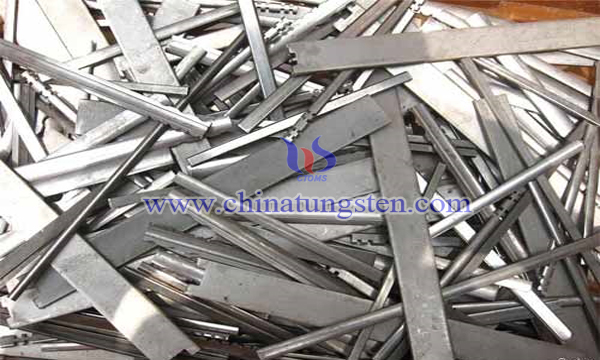Tungsten Carbide Fibers Reformed by Waste Tungsten
- Details
- Category: Tungsten Information
- Published on Friday, 27 July 2018 10:40
Tungsten carbide (WC) is a black six party crystal with metallic luster and hardness similar to diamond. It is an important cemented carbide material. In the new field of science and technology, tungsten carbide has the catalytic effect of platinum like (Pt).

Because the catalytic activity of pure tungsten carbide is lower than the catalytic activity of the metal catalyst, the only way to prepare continuous nanofibers is the electrostatic spinning method, using the high pressure (thousands volt to several kilovolt) to obtain the micro nano scale tungsten carbide (nanofibers, nanofibers, nanotubes, etc.) with a larger specific surface area. The electric field acts on polymer solution or molten liquid to obtain micro nano scale (50 to 500nm) polymer nanofibers. With six tungsten chloride (WCl6) as raw material, there is also a high demand for raw materials and high cost.
To solve the above problems, this paper introduces a method of making micro nano tungsten carbide fiber from tungsten scrap, which includes the following steps:
(1) Prepare ammonium tungstate water from tungsten waste. (2) Prepare micro nano polyacrylonitrile fiber by electro spinning. (3) Preoxidation of micro nano polyacrylonitrile raw fiber. (4) Ammonium paratungstate / nano polyacrylonitrile fiber composite primary fibers were prepared by impregnating aqueous ammonium tungstate solution and impregnating the micro nano polyacrylonitrile fibers. (5) Micro nano tungsten carbide fibers were prepared by carbonization of ammonium tungstate / micro nano polyacrylonitrile fiber primary composite fiber in a reducing furnace containing reduced gases. The examples are as follows:
(1) Tungsten waste is taken from tungsten leaching residue. The main components were 3.4%WO3, 20.6%Fe, 12%Mn and 2.1%CaO. The tungsten leaching residue of 500g was calcined for 8h at 630°C. After the roasting material is cooled, 60 mesh sieves are used. Subsequently, 18.5% (mass fraction) of ammonia was leached, and the leaching temperature was 85°C, all the tungsten oxide was dissolved until the time was 8h. After filtration, the filtrate was evaporated and concentrated. The pH value was adjusted to 6.3, and the temperature was reduced to 13°C and 4H was kept. The content of tungsten trioxide contained in the sample is 88%, which is qualified. The ammonium paratungstate crystal was heated to 4h and heated at 255°C. Then the deionized water was added and the thermal dissociation products were leached. The liquid-solid ratio was 8: 1. The pH value of the solution should always be kept at 3.5 during boiling at 4H at 90°C. The transparent supernatant can be obtained by cooling and clarifying the liquid, then the insoluble residue is filtered and the ammonium tungstate solution is obtained. Ammonium metatungstate solution was concentrated, crystallized, filtered and dried to obtain ammonium tungstate solid.
(2) 9mg's polyacrylonitrile (PAN) powder (molecular weight is 23000) is mixed with N and N- methyl formamide of 10ml and is sealed in a magnetic stirrer at normal temperature until the solution is uniform and transparent, so that the polymer is fully dissolved in the organic solvent. The polyacrylonitrile solution prepared from about 4ml is poured into the plastic syringe and is fitted with a metal needle with an inner diameter of 0.45nm. The spinning process was carried out at 15kV voltage, and the micro nano polyacrylonitrile fiber was received by the aluminum chip collection device. The diameter of the micro nano polyacrylonitrile fiber is 100 ~ 500nm.
(3) The polyacrylonitrile fiber was heated to 300°C and kept for 25 minutes to complete the pre oxidation process.
(4) Ammonium tungstate solution was prepared by dissolving 335mg ammonium tungstate solid (WO3 content of 88%) in 10mL water. The pre oxidized nano polyacrylonitrile raw fiber was immersed in ammonium polytungstate solution, and the primary composite fiber of ammonium polytungstate / micro nano polyacrylonitrile fiber was prepared until the template was soaked with ammonium tungstate water solution. Then, the 18h was dried naturally.
(5) The primary composite fiber of ammonium polytungstate / micro nano polyacrylonitrile fiber was carbonized in a reducing furnace with H2 and C2H2 mixed gas (the volume ratio of H2 and C2H2 was 1: 5). The carbonization temperature was raised to 950°C, the micro nano tungsten carbide fibers were prepared for 2 hours.
The tungsten carbide fiber is used as raw material in this method. The diameter of tungsten carbide fiber is micro nanoscale, the surface area is larger, the production cost is greatly reduced, and the recycling of tungsten waste is also promoted at the same time.
- Tungsten Manufacturer & Supplier, Chinatungsten Online: www.chinatungsten.com
- Tungsten News & Prices of China Tungsten Industry Association: www.ctia.com.cn
- Molybdenum News & Price: news.molybdenum.com.cn
- Tel.: 86 592 5129696; Fax: 86 592 5129797; Email: sales@chinatungsten.com



 sales@chinatungsten.com
sales@chinatungsten.com